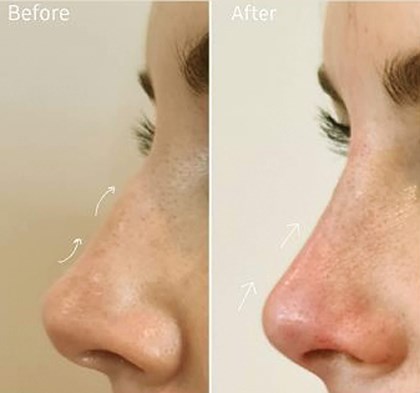Year on year non-surgical rhinoplasty (NSR) has become increasingly popular and after first learning the technique with a needle, I was taught the cannula technique. Currently, I practise both techniques regularly and often use threads on bulky noses.
Indications
The main indications are:
- Dorsal nasal hump
- Widening of the nose
- Drooping of the tip
- Irregularities following surgical rhinoplasty or trauma
- Increasing the height of the nasal bridge (ethnic variations)
- Achieving a sharper (more pointy) tip.
It is essential to assess the psychological history of the patient and to rule out body dysmorphia.
Measurements
The alar margins should be equal to the distance between the inner and the outer canthi of the eyes. The nose becomes more sunken and appears wider with age due to lack of structural support.
The distance from the top of our nose to the centre of the lips should be 1.6 times the distance from the middle of the lips to the bottom of our chin. The tip droops with age and the philtrum appears longer.
The ideal nasolabial angle is reported to be 93.4 to 98.5 degrees for men and 95.5 to 100.1 degrees for women [1]. This is, of course, very subjective.
Ratios aside, the nasal-glabellar-orbital region should be taken into consideration and this entails a knowledge of variations across ethnicities.
Preparation
The following instruments are required:
- A 38mm 25G cannula is used. I prefer to use TSK cannulae as they offer the advantage of having the right amount of flexibility. The high quality of steel allows for a smooth passage into the columella, enhancing patient comfort.
- Surgical marker
- Sterile dressing pack
- High G prime filler
- Good lighting
- Plain lidocaine 2%.
We start with an infraorbital nerve block, which anaesthetises the lower eyelid, upper cheek, part of the nose, and upper lip. If doing a nasal-glabellar harmonisation, a supratrochlear block is also performed. Personally, I add 0.2ml of lidocaine at the root of the nose as well. If threads are being used, infiltration anaesthesia is preferred. The nose is thoroughly disinfected using hypochlorous. Landmarks are identified and marked. Vasculature is mapped with ultrasound.


Procedure
- An entry point is created at the infratip.
- The needle is removed and the cannula inserted with the dominant hand towards the root of the nose. Filler is deposited supraperiosteal with an initial bolus followed by a retrograde thread. This is repeated to achieve the desired lift. Exercise caution to avoid over elevation which results in a ‘pig like’ nose.
- The cannula is redirected to the bridge.
- The cannula should be in the supraperiosteal plane.
- Filler is deposited to correct irregularities.
- No filler should be deposited on a dorsal hump (this will make the defect worse).
- The tip can be sharpened by directing the cannula in the desired direction and a straighter bridge can be achieved.
- Care should be taken not to obliterate the space between the radix and the glabella.
- The cannula is removed and the filler is massaged as required.
Treating age-related widening of the nose
This involves in my experience treating the nasalis with botulinum toxin and treating the pirifom fossa with filler. I would usually use 2 units of onabotulinumtoxin A on each ala and treat the piriform with a high G prime filler with a supraperiosteal depot and retrograde injection.
Precautions
- Avoid wearing glasses for three weeks.
- Avoid pressing on the nose.
- Advise the patient that there may be swelling which gradually settles over three weeks.
- Caution against bruising.
- Patient advised to keep the area clean using a post procedure cream with an antiseptic.
- Patient to report any signs of infection immediately.
Reference
1. Armijo BS, Brown M, Guyuron B. Defining the ideal nasolabial angle. Plast Reconstr Surg 2012;129(3):759-64.
Further reading
-
Alfertshofer MG, Frank K, Ehrl D, et al. The layered anatomy of the nose: an ultrasound-based investigation. Aesthet Surg J 2021; [Epub ahead of print].
-
Chia J, Archibald J, Murray C, et al. Surface anatomy of the nose for the dermatologist. J Cutan Med Surg 2013;17:143-6.
-
Daniel R, Kosins A, Sajjadian A, et al. Rhinoplasty and brow modification. Aesthet Surg J 2013;33(7):983-94.
-
Lee W, Kim JS, Oh W, et al. Nasal dorsum augmentation using soft tissue filler injection. J Cosmet Dermatol 2019; [Epub ahead of print].
-
Park CW, Lee MJ, Jung YI. Photogrammetric facial analysis of attractive celebrities using the glabella for planning rhinoplasty and analyzing surgical outcomes. Arch Aesthetic Plast Surg 2018;24(3):105-10.
-
Park J, Yun S, Son D. Changes in eyebrow position and movement with aging. Arch Plast Surg 2017;44(1):65-71.
-
Patel BC, Malhotra R. Mid forehead brow lift. StatPearls [Internet] Treasure Island, FL, USA; StatPearls Publishing; 2021.
Declaration of competing interests: None declared.
COMMENTS ARE WELCOME










